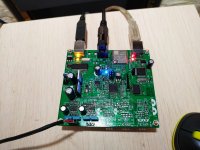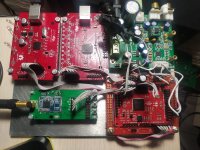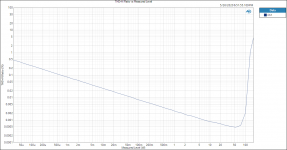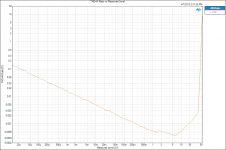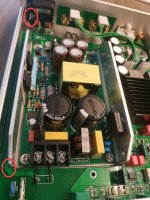I put a Khadas Tone Board DAC inside my amp. It has lots of favourable reviews and Audio Science Review rates it highly. I used a usb c panel mount extension and the rca plugs with screw terminals to connect it. It was about £100. It also comes with 2mm standoffs. It also has a coax input which I have not used but plan to in the future. I will make the connection for the coax with a female to female rca socket and a 20cm rca lead.
Compared to the DAC in my DX160 it has a more analog sound without being less precise. I’m sure there are better DACs out there but for the money nothing comes close to the KTB.
I saw your great DIY amplifier. Nice looking amp by the way )
I might be stupid, but what about ADAU1701 (we are speaking) VS Khadas (ES9038Q2M based) and VS DX160 (CS43198 based) ?
You probably mean Khadas is the best affordable DAC ?
Last edited:
The increased drive voltage is not directly applied to the input terminal, but to the PFFB-network. Theoretically, you could increase drive level without limits - if your AFE delivers[/QUOTE
I am unable to see it. PFFB is connected to input of TPA325X (and its limitations)
It is not, there is R_in in series as can be seen at the beginning of SLA744. And that makes the difference. If you look at an inverting op-amp, the signal at the input pin is not input level but close to zero. And this is just the same feedback network structure. Level at TPA3255 input pin will always be output level -21.5dB
Last edited:
It is not, there is R_in in series as can be seen at the beginning of SLA744. And that makes the difference. If you look at an inverting op-amp, the signal at the input pin is not input level but close to zero. And this is just the same feedback network structure. Level at TPA3255 input pin will always be output level -21.5dB
I see what you mean.. will test it with 6db input gain
Hi DrMord
What is the best choice that you would recommend?
Hi Mo!
I use PCM1798, PCM5102, ES9018. And internal DACs ADAU1701's
Bested - 1th ES9018,2th PCM1798,3th PCM5102.
I have PCM1794 and AK4458 chips. I do DAC later.
My DSPs selfmade ADAU1452, out DACs PCM5102.
And assembled from China DAC ES9018 and chipdip.ru parts as ADAU1467, USB-I2S STM32f446, Sigmalink programmer.
Attachments
My main source has been a Mac Mini and the DAC used in this model is not bad and I have been happy to date. Apple seem to do a good job with their DAC implementations.
I recently started to use an Apple Airport Express (latest model) to feed directly into the amplifier (RCA Inputs). The DAC in this model also has quite a good reputation and it makes it really easy to stream music from my various Apple Devices - including the Mac Mini to the amplifier and speakers which have now been moved to the other side of the room.
I don't see many comments on here about using Apple devices as a source.
I use a Mac mini mid 2010 as a source. The Khadas Tone Board connects to it without any drivers and then setup with the Midi settings in the macs utilities.
Sadly my Macs own DAC to 3.5mm jack is terrible with lots of hissing.
I use the Audirvana player which is excellent and has a great remote app.
I saw your great DIY amplifier. Nice looking amp by the way )
I might be stupid, but what about ADAU1701 (we are speaking) VS Khadas (ES9038Q2M based) and VS DX160 (CS43198 based) ?
You probably mean Khadas is the best affordable DAC ?
I’m a noob when it comes to DIY audio but enjoy doing a bit of research and sharing my limited experience. From what I’ve read the Khadas can compete against some very expensive DACs. From listening to the Khadas I believe all the good things said about it. When I got my first Yamaha amp over 20 years ago it blew me away, the Khadas surpassed my expectations too.
I don’t know anything about the ADAU1701.
You say that loss of gain in the amp has to be compensated in opamp stage , but as you know we have a maximum input voltage on the analog inputs...there simply is no way we can increase by 5db a 4Vrms signal without going over max input voltage
It is not, there is R_in in series as can be seen at the beginning of SLA744. And that makes the difference. If you look at an inverting op-amp, the signal at the input pin is not input level but close to zero. And this is just the same feedback network structure. Level at TPA3255 input pin will always be output level -21.5dB
Even if the boosting opamp were a non-inverting amplifier with the PFFB applied to it's inverting input, it's output signal and hence the TPA's input signal weren't larger in the closed loop, as the input opamp amplifies just the difference between it's inverting and non-inverting inputs.
Best regards!
I am sorry to say but hearing experience varies from person to person and does not deliver revisable data. So I do keep away from any discussions based on non measured data.
You may call me an objectivist hardliner
Just my 2 c
I'm with you 100% on the above... which is why I'm confused about your standpoint on PFFB.
The reason I've avoided class D all these years is 2-fold:
1. Output noise - almost all non PFFB implementations have clearly audible output noise when driving wideband transducers. Not an issue with subwoofers so much, but I cannot stand audible noise from an idle system. If you can't get your noise levels below the audible threshold then you're likely wasting your time with other modifications.
2. SINAD - Outside of subwoofer use, the reality for almost all amplifiers is that they do indeed operate in the mW to ~2W range for 99% of their operating time. Rare peaks and loud transients may very briefly exceed this, but most of what you hear is the amplifiers performance between 0W and 2W. Class D amplifiers are terrible in this area... falling short of even tube based implementations at lower power levels.
As an objectivist, getting a 6dB improvement in both the above for the cost of a nice op-amp (OPA1632 ~$1.15) and a few discretes (~30 cents) is likely the best value for money you will get in your entire system chain. For those less technical, 6dB sounds like "only 6" which is not a big number, but 6dB means half as much... half as much output noise, and half as much output distortion. Or to put it another way, any non PFFB arrangement has double the distortion and double the noise.
The next argument will be: "but you cannot hear the difference between 0.001%THD and 0.0005%THD." and I would agree with you. There are no loudspeakers on the planet with distortion that low, so claiming to hear that through even a good set of headphones with 0.05% THD is dubious at best. But that figure happens at 50W output into an 8ohm load! I don't know about you, but I don't listen to music at those output levels for very long... and when I do, I'm too buys playing air guitar to notice
Where is does matter is in the >1W territory where you will spend most of your time listening critically. In this area we could be talking about the difference between 0.5%THD+N and 1%THD+N and that is absolutely in the realm of audibility.
Attached is a plot from the monoblock TPA3255 I just finished with PFFB.
Also attached is a plot from my MPUHP 50W class A/B amplifier from a few years ago. Sure, the difference in peak THD+N performance is only 0.0004% vs 0.0005% certainly not audible, but it's everywhere else below 2W where the Class AB amp is a factor of 5x-6x better when it comes to THD+N. This is why I can't stand single-point distortion figures for amplifiers. They are largely meaningless unless you fully quantify the where/what/when of that single point.
Regards,
Owen
Attachments
Last edited:
My amp is totally silent and any noise is from the source. When I built it I had trouble finding a source clean enough and had to resort to an old iPhone 5. Both my Mac and tv were humming and hissing! Even a lot of my music needed to be replaced with cleaner versions. I’ve only used the 3E Audio 3255 & 3251 and neither produce any audible noise, they are both ridiculously sensitive.
I use the usb output from my Mac to a Khadas DAC or the 3.5 from my iBasso DX160 DAP as a source.
I use the usb output from my Mac to a Khadas DAC or the 3.5 from my iBasso DX160 DAP as a source.
Last edited:
I use a Mac mini mid 2010 as a source. The Khadas Tone Board connects to it without any drivers and then setup with the Midi settings in the macs utilities.
Sadly my Macs own DAC to 3.5mm jack is terrible with lots of hissing.
I use the Audirvana player which is excellent and has a great remote app.
My Mac Minis a 2014 model and the 3.5 Jack output is very clean. Just fed directly into the RCA sockets on the amplifier.
I am aware of the Audirvana Player and it looks very nice. I just don't have enough incentive at the moment to make the investment. There is so much good source material on YouTube.
...
To take advantage of less than 6dB lower THD figures the driving op-amp must deliver 6dB more output level – at a very low distortion.
...
Not to take this out of context (I hope!), but with as many "hot" DACs out there as there is nowadays, I consider this more a feature (lower input sensitivity) than a detraction. As you well know ideal gain structure is all up at the very front of the signal chain, minimizing downstream noise/RF incursion.
I haven't converted my EVM modules to PFFB and added a new analog frontend (if I even need to vs using the already-there 5532's) because I'm lazy.
Agree wholeheartedly with you about sound quality vs just having fun pushing circuit performance.
Opc, I'm also running 3e 3255 in balanced mode (so the onboard opamps are not in use) and the board is dead silent with dac even at full volume. I use Meanwell a 48V psu. No hiss with my ear next to the 88db speaker. I modded my dac to give out a very high output signal so it drives the 3e board directly. I can't remember if the amp was dead silent with the opamps.
Hi amigos,
New TPA3255 under my hands)
Let's start a little review with a 3h listening test.
Setup :
BRZHIFI TPA3255 amplifier
SMPS LLC integrated PSU
4 OP Amps DIP8 socket
Bluetooth QC. Chipset.
3-band equalizer
High end Floor speakers (Ribbon tweeter)
93DB / 100RMS / 8 ohms
Source :
HD Audio Quboz streaming
Jazz / WorldMusic / Classical playlist
Options :
AK4497 double dac.
Quad DAC ESS (V30).
A first sight : When I removed the top enclosure panel, I started to measure the LLC PSU that seems good. But something is weird, I measured it @ 40V. The Voltage can be adjusted to +/- 5%. (I already knew this before ordering). I have the same PSU in my other PSU enclosure. The Amplifier is provided with 4 OP amps... I guess 2 are dedicated to Equalizer ? It comes with 4 NE5532.
I removed those OP Amps and installed 4 TI OPA1656 instead. (improvement is huge, I really do not exagerate), I wonder if it because it uses 4 OP amps but it's even more noticeable than on my AIYIMA TPA3251, especially when it comes to volume gain.
So here the + and - :
Plus :
ANTI POP circuit yeahhhhhh )
4 removable OP amps
Equalizer works really fine ! you can clearly juggle between frequencies
Good looking design, full Aluminium enclosure (well ventilated)
Integrated LLC PSU
PCB seems good
Dead silence amplifier, no Hiss, no noise
the amplifier does not heat up even after 3 hours of listening
- :
PSU is only 40V ? I wonder why !
Because of this, the Amplifier do not deliver is best power
Volume Knob seems a bit fragile
Personnaly, I would prefer it without Bluetooth chip (subjective)
Only silver case, I would like a black one.
No PFFB
Sound quality :
With the 4 OPA1656, compared to the AIYIMA TPA3251. I found the Bass being sweeter, the fact you can juggle the equalizer is really fine and brings something very interesting.
With my ribbon speakers, I set the trebles forward, cymbals and fairly incisive percussion sound awesome. Medium are just fine, I left the Medium at 12:00
The amplifier is absolutely dead silence, no hiss, no noises, nothing to complain about )
So this is good alternative to the AIYIMA TPA3251.
Since the amplifier is completely different from the AIYIMA TPA3251, I can't say so much about the caps, electronic etc...
Here we have a good TPA3255 Amplifier, with anti Pop at startup which is really appreciated. I really like the fact the SMPS LLC PSU is integrated.
The enclosure size remains compact while preserving a sober solid design.
As a reminder, this is my 5th TPA32XX and I am still waiting for my TPA32XX based on 360 Customs design. So I will be able, later, to compare it to the top end TPA32XX.
For the moment, I am loving it as I still love my AIYIMA TPA3251.
I paid it about 90 euros, it is a bargain as well )
Pictures :







New TPA3255 under my hands)
Let's start a little review with a 3h listening test.
Setup :
BRZHIFI TPA3255 amplifier
SMPS LLC integrated PSU
4 OP Amps DIP8 socket
Bluetooth QC. Chipset.
3-band equalizer
High end Floor speakers (Ribbon tweeter)
93DB / 100RMS / 8 ohms
Source :
HD Audio Quboz streaming
Jazz / WorldMusic / Classical playlist
Options :
AK4497 double dac.
Quad DAC ESS (V30).
A first sight : When I removed the top enclosure panel, I started to measure the LLC PSU that seems good. But something is weird, I measured it @ 40V. The Voltage can be adjusted to +/- 5%. (I already knew this before ordering). I have the same PSU in my other PSU enclosure. The Amplifier is provided with 4 OP amps... I guess 2 are dedicated to Equalizer ? It comes with 4 NE5532.
I removed those OP Amps and installed 4 TI OPA1656 instead. (improvement is huge, I really do not exagerate), I wonder if it because it uses 4 OP amps but it's even more noticeable than on my AIYIMA TPA3251, especially when it comes to volume gain.
So here the + and - :
Plus :
ANTI POP circuit yeahhhhhh )
4 removable OP amps
Equalizer works really fine ! you can clearly juggle between frequencies
Good looking design, full Aluminium enclosure (well ventilated)
Integrated LLC PSU
PCB seems good
Dead silence amplifier, no Hiss, no noise
the amplifier does not heat up even after 3 hours of listening
- :
PSU is only 40V ? I wonder why !
Because of this, the Amplifier do not deliver is best power
Volume Knob seems a bit fragile
Personnaly, I would prefer it without Bluetooth chip (subjective)
Only silver case, I would like a black one.
No PFFB
Sound quality :
With the 4 OPA1656, compared to the AIYIMA TPA3251. I found the Bass being sweeter, the fact you can juggle the equalizer is really fine and brings something very interesting.
With my ribbon speakers, I set the trebles forward, cymbals and fairly incisive percussion sound awesome. Medium are just fine, I left the Medium at 12:00
The amplifier is absolutely dead silence, no hiss, no noises, nothing to complain about )
So this is good alternative to the AIYIMA TPA3251.
Since the amplifier is completely different from the AIYIMA TPA3251, I can't say so much about the caps, electronic etc...
Here we have a good TPA3255 Amplifier, with anti Pop at startup which is really appreciated. I really like the fact the SMPS LLC PSU is integrated.
The enclosure size remains compact while preserving a sober solid design.
As a reminder, this is my 5th TPA32XX and I am still waiting for my TPA32XX based on 360 Customs design. So I will be able, later, to compare it to the top end TPA32XX.
For the moment, I am loving it as I still love my AIYIMA TPA3251.
I paid it about 90 euros, it is a bargain as well )
Pictures :







My Mac Minis a 2014 model and the 3.5 Jack output is very clean. Just fed directly into the RCA sockets on the amplifier.
I am aware of the Audirvana Player and it looks very nice. I just don't have enough incentive at the moment to make the investment. There is so much good source material on YouTube.
I had not used the jack on the Mac mini much so it probably full of dust! I am buying the Audirvana player this weekend, I did the 30 day free trial twice (sorry Audirvana).
Do the free trial, you only need an email and there is no credit card info. The remote app works well and is android or iPhone. It also connects to Tidal and Qobuz accounts too even the free trial versions (yes I had Audirvana, Tidal and Qobuz all working together and all on trial lol)
My amp is totally silent and any noise is from the source. When I built it I had trouble finding a source clean enough and had to resort to an old iPhone 5. Both my Mac and tv were humming and hissing! Even a lot of my music needed to be replaced with cleaner versions. I’ve only used the 3E Audio 3255 & 3251 and neither produce any audible noise, they are both ridiculously sensitive.
I use the usb output from my Mac to a Khadas DAC or the 3.5 from my iBasso DX160 DAP as a source.
Opc, I'm also running 3e 3255 in balanced mode (so the onboard opamps are not in use) and the board is dead silent with dac even at full volume. I use Meanwell a 48V psu. No hiss with my ear next to the 88db speaker. I modded my dac to give out a very high output signal so it drives the 3e board directly. I can't remember if the amp was dead silent with the opamps.
This will of course depend on your setup, but I'm a bit skeptical of claims of dead silence from right next to the loudspeaker.
The output noise without PFFB is 85uV A-wt. (directly from 3e audio website). Assuming a 95dB sensitive 4ohm tweeter (extremely common) that would be 71dBSPL at 3cm distance (ear right near the speaker). Your setup may vary, or room background noise/tinnitus may be a factor, but everyone should be able to hear 71dBSPL.
If you have an 8 ohm speaker with closer to 88dB 1W/1m sensitivity then you're looking at 58dBSPL at the same 30mm distance. Again, this should be clearly audible, not dead silent.
Bringing that back out to 1m distance you should be well below any room background noise at 28dBSPL which would make it inaudible. In my opinion, that's a perfectly acceptable noise level. It's probably best to target less than 40dBSPL@1m noise levels unless you're listening at very nearfield or in an anechoic chamber
I feel that my point remains valid... if you can get 6dB less output noise and distortion for ~$1.45 then that's probably money very well spent. You could drop a lot more on other modifications and get absolutely no quantifiable benefit. Cutting output noise and distortion by half is definitely quantifiable, and definitely audible.
Regards,
Owen
I agree that THD as well as noise with actual class d is one order of magnitude worse compared to a my reference AB-amp, for instance. In my younger years I was quite finicky with any noise and that's why I hated any tape recorders. At this time I considered 90dB dynamic range as the goal for satisfying audio. Even class d-amps are better than 100dB S/N now so I really wonder how the residual noise will disturb you.I'm with you 100% on the above... which is why I'm confused about your standpoint on PFFB.
The reason I've avoided class D all these years is 2-fold:
1. Output noise - almost all non PFFB implementations have clearly audible output noise when driving wideband transducers. Not an issue with subwoofers so much, but I cannot stand audible noise from an idle system. If you can't get your noise levels below the audible threshold then you're likely wasting your time with other modifications.
2. SINAD - Outside of subwoofer use, the reality for almost all amplifiers is that they do indeed operate in the mW to ~2W range for 99% of their operating time. Rare peaks and loud transients may very briefly exceed this, but most of what you hear is the amplifiers performance between 0W and 2W. Class D amplifiers are terrible in this area... falling short of even tube based implementations at lower power levels.
As an objectivist, getting a 6dB improvement in both the above for the cost of a nice op-amp (OPA1632 ~$1.15) and a few discretes (~30 cents) is likely the best value for money you will get in your entire system chain. For those less technical, 6dB sounds like "only 6" which is not a big number, but 6dB means half as much... half as much output noise, and half as much output distortion. Or to put it another way, any non PFFB arrangement has double the distortion and double the noise.
The next argument will be: "but you cannot hear the difference between 0.001%THD and 0.0005%THD." and I would agree with you. There are no loudspeakers on the planet with distortion that low, so claiming to hear that through even a good set of headphones with 0.05% THD is dubious at best. But that figure happens at 50W output into an 8ohm load! I don't know about you, but I don't listen to music at those output levels for very long... and when I do, I'm too buys playing air guitar to notice
Where is does matter is in the >1W territory where you will spend most of your time listening critically. In this area we could be talking about the difference between 0.5%THD+N and 1%THD+N and that is absolutely in the realm of audibility.
Attached is a plot from the monoblock TPA3255 I just finished with PFFB.
Also attached is a plot from my MPUHP 50W class A/B amplifier from a few years ago. Sure, the difference in peak THD+N performance is only 0.0004% vs 0.0005% certainly not audible, but it's everywhere else below 2W where the Class AB amp is a factor of 5x-6x better when it comes to THD+N. This is why I can't stand single-point distortion figures for amplifiers. They are largely meaningless unless you fully quantify the where/what/when of that single point.
Regards,
Owen
Can anyone spot the lethal double whammy in the attached image?
I'd be more concerned about that than the sound quality
You are afraid it will catch fire lol
I personnaly buy an amplifier for its sound ... we can list all its faults it is sure...
It is not a $1000 amplifier amigo ) If you need $1 to set the ground, hummm ....
Last edited:
You are afraid it will catch fire lol
I personnaly buy an amplifier for its sound ... we can list all its faults it is sure...
It is not a $1000 amplifier amigo ) If you need $1 to set the ground, hummm ....
It is a piece of equipment connected to mains supply. No mercy on this kind of dilettantism.
- Home
- Amplifiers
- Class D
- TPA3255 - all about DIY, Discussion, Design etc
